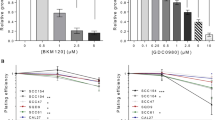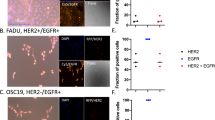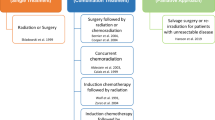Abstract
We previously demonstrated that 15-LOX-2 is significantly reduced in head and neck carcinoma and restoration of 15-LOX-2 expression results in tumor inhibition in HNC. The aim of this study is to evaluate 15-LOX-2 as a candidate for targeted radiotherapy. Molecular subcloning was performed to create a radiation-inducible 15-LOX-2 expression vector in which the full-length 15-LOX-2 cDNA was inserted downstream the recombinant Egr-1 promoter. The radiation-induced downregulations of 15-LOX-2 protein (twofold up) and its main metabolite 15S-HETE (threefold up) were observed in HNC cells transfected with the 15-LOX-2 expression vector after 4 Gy of radiation. Radiation-induced upregulation of 15-LOX-2 resulted in significant induction of apoptosis in HNC cells. Furthermore, survival colony formation was significantly reduced by 4 Gy in the HNC cells containing the 15-LOX-2 expression vector compared with the controls. Radiation-induced upregulation of 15-LOX-2 results in significant induction of apoptosis and enhances killing effect of radiotherapy in HNC. In addition, exogenous addition of 15S-HETE at high concentrations (⩾10 μM) but not at low concentrations induced upregulation of its endogenous ligand PPARγ. In conclusion, synergistic effect between radiation and 15-LOX-2 was observed in killing HNC. 15-LOX-2 may be a potential target in radiation-targeted therapy of HNC. The 15-LOX-2 inhibition may not be PPARγ dependent.
This is a preview of subscription content, access via your institution
Access options
Subscribe to this journal
Receive 12 print issues and online access
$259.00 per year
only $21.58 per issue
Buy this article
- Purchase on Springer Link
- Instant access to full article PDF
Prices may be subject to local taxes which are calculated during checkout






Similar content being viewed by others
Abbreviations
- 15-LOX-2:
-
15-lipoxygenase 2
- 15S-HETE:
-
15S- hydroxyeicosatetraenoic acid
- AA:
-
arachidonic acid
- Egr-1:
-
early growth response 1 gene
- GAPDH:
-
glyceraldehyde-3-phosphate dehydrogenase
- HNC:
-
head-and-neck cancer
- PPARγ:
-
peroxisome proliferators-activated receptor γ
References
Chao KS . Protection of salivary function by intensity-modulated radiation therapy in patients with head and neck cancer. Semin Radiat Oncol 2002; 12 (Suppl 1): 20–25.
Eisbruch A . Clinical aspects of IMRT for head-and-neck cancer. Med Dosim 2002; 27: 99–104.
Mezhir JJ, Smith KD, Posner MC, Senzer N, Yamini B, Kufe DW et al. Ionizing radiation: genetic switch for cancer therapy. Cancer Gene Ther 2006; 13: 1–6.
Keyse SM . The induction of gene expression in mammalian cells by radiation. Semin Cancer Biol 1993; 4: 119–128.
Weichselbaum RR, Hallahan DE, Beckett MA, Mauceri HJ, Lee H, Sukhatme VP et al. Gene therapy targeted by radiation preferentially radiosensitizes tumor cells. Cancer Res 1994; 54: 4266–4269.
Hallahan DE, Mauceri HJ, Seung LP, Dunphy EJ, Wayne JD, Hanna NN et al. Spatial and temporal control of gene therapy using ionizing radiation. Nat Med 1995; 1: 786–791.
Kim SH, Kim JH, Kolozsvary A, Brown SL, Freytag SO . Preferential radiosensitization of 9L glioma cells transduced with HSV-tk gene by acyclovir. J Neurooncol 1997; 33: 189–194.
Meyer RG, Kupper JH, Kandolf R, Rodemann HP . Early growth response-1 gene (Egr-1) promoter induction by ionizing radiation in U87 malignant glioma cells in vitro. Eur J Biochem 2002; 269: 337–346.
Datta R, Rubin E, Sukhatme V, Qureshi S, Hallahan D, Weichselbaum RR et al. Ionizing radiation activates transcription of the EGR-1 gene via CArG elements. Proc Natl Acad Sci 1992; 89: 10149–10153.
Hallahan DE, Spriggs DR, Beckett MA, Kufe DW, Weichselbaum RR . Increased tumor necrosis factor alpha mRNA after cellular exposure to ionizing radiation. Proc Natl Acad Sci 1989; 86: 10104–10107.
Senzer N, Mani S, Rosemurgy A, Nemunaitis J, Cunningham C, Guha C et al. TNFerade biologic, an adenovector with a radiation-inducible promoter, carrying the human tumor necrosis factor alpha gene: a phase I study in patients with solid tumors. J Clin Oncol 2004; 22: 592–601.
Mundt AJ, Vijayakumar S, Nemunaitis J, Sandler A, Schwartz H, Hanna N et al. A phase I trial of TNFerade biologic in patients with soft tissue sarcoma in the extremities. Clin Cancer Res 2004; 10: 5747–5753.
Brash AR, Boeglin WE, Chang MS . Discovery of a second 15S-lipoxygenase in humans. Proc Natl Acad Sci 1997; 94: 6148–6152.
Attar TE, Lin H . Prostaglandin synthesis by squamous carcinoma cells of head and neck, and its inhibition by non-steroidal anti-inflammatory drugs. J Oral Pathol 1987; 16: 483–487.
Cherukuri DP, Nelson MA . Do elevated levels of eicosanoids play a role in head and neck cancer recurrence and metastasis? Implications for prevention and treatment. Cancer Biol Ther 2004; 3: 853–854.
Shappell SB, Boeglin WE, Olson SJ, Kasper S, Brash AR . 15-lipoxygenase-2 (15-LOX-2) is expressed in benign prostatic epithelium and reduced in prostate adenocarcinoma. Am J Pathol 1999; 155: 235–245.
Xu XC, Shappell SB, Liang Z, Song S, Menter D, Subbarayan V et al. Reduced 15S-lipoxygenase-2 expression in esophageal cancer specimens and cells and upregulation in vitro by the cyclooxygenase-2 inhibitor, NS398. Neoplasia 2003; 5: 121–127.
Wang D, Chen S, Feng Y, Yang Q, Campbell BH, Tang X et al. Reduced expression of 15-lipoxygenase 2 in human head and neck carcinomas. Tumor Biol 2006; 27: 261–273.
Subbarayan V, Xu XC, Kim J, Yang P, Hoque A, Sabichi AL et al. Inverse relationship between 15-lipoxygenase-2 and PPAR-γ gene expression in normal epithelia compared with tumor epithelia. Neoplasia 2005; 7: 280–293.
Jack GS, Brash AR, Olson SJ, Manning S, Coffey CS, Smith JA et al. Reduced 15-lipoxygenase-2 immunostaining in prostate adenocarcinoma: correlation with grade and expression in high-grade prostatic intraepithelial neoplasia. Hum Pathol 2000; 31: 1146–1154.
Tang S, Bhatia B, Maldonado CJ, Yang P, Newman RA, Liu J et al. Evidence that arachidonate 15-lipoxygenase 2 is a negative cell cycle regulator in normal prostate epithelial cells. J Biol Chem 2002; 277: 16189–16201.
Bhatia B, Tang S, Yang P, Doll A, Aumüeller G, Newman RA et al. Cell-autonomous induction of functional tumor suppressor 15-lipoxygenase 2 (15-LOX-2) contributes to replicative senescence of human prostate progenitor cells. Oncogene 2005; 24: 3583–3595.
Chen Y, Sato M, Fujimura S, Endo C, Sakurada A, Aikawa H et al. Expression of Bcl-2, Bax, and p53 proteins in carcinogenesis of squamous cell lung cancer. Anticancer Res 1999; 19: 1351–1356.
Dey S, Spring PM, Arnold S, Valentino J, Chendil D, Regine WF et al. Low-dose fractionated radiation potentiates the effects of paclitaxel in wild-type and mutant p53 head and neck tumor cell lines. Clin Cancer Res 2003; 9: 1557–1565.
Marples B, Scott SD, Hendry JH, Embleton MJ, Lashford LS, Margison GP . Development of synthetic promoters for radiation-mediated gene therapy. Gene Ther 2000; 7: 511–517.
Park JO, Lopez CA, Gupta VK, Brown CK, Mauceri HJ, Darga TE et al. Transcriptional control of viral gene therapy by cisplatin. J Clin Invest 2002; 110: 403–410.
Nagy L, Tontonoz P, Alvarez JG, Chen H, Evans RM . Oxidized LDL regulates macrophage gene expression through ligand activation of PPARgamma. Cell 1998; 93: 229–240.
Huang JT, Welch JS, Ricote M, Binder CJ, Willson TM, Kelly C et al. Interleukin-4-dependent production of PPAR-gamma ligands in macrophages by 12/15-lipoxygenase. Nature 1999; 400: 378–382.
Sarraf P, Mueller E, Jones D, King FJ, DeAngelo DJ, Partridge JB et al. Differentiation and reversal of malignant changes in colon cancer through PPARgamma. Nat Med 1998; 4: 1046–1052.
Elstner E, Muller C, Koshizuka K, Williamson EA, Park D, Asou H et al. Ligands for peroxisome proliferator-activated receptorgamma and retinoic acid receptor inhibit growth and induce apoptosis of human breast cancer cells in vitro and in BNX mice. Proc Natl Acad Sci USA 1998; 95: 8806–8811.
Chang TH, Szabo E . Induction of differentiation and apoptosis by ligands of peroxisome proliferator-activated receptor gamma in non-small cell lung cancer. Cancer Res 2000; 60: 1129–1138.
Shappell SB, Gupta RA, Manning S, Whitehead R, Boeglin WE, Schneider C et al. 15S-Hydroxyeicosatetraenoic acid activates peroxisome proliferator-activated receptor gamma and inhibits proliferation in PC3 prostate carcinoma cells. Cancer Res 2001; 61: 497–503.
Hsi LC, Wilson LC, Eling TE . Opposing effects of 15-lipoxygenase-1 and -2 metabolites on MAPK signaling in prostate. Alteration in peroxisome proliferator-activated receptor gamma. J Biol Chem 2002; 227: 40549–40556.
Subbarayan V, Krieg P, Hsi LC, Kim J, Yang P, Sabichi AL et al. 15-Lipoxygenase-2 gene regulation by its product 15-(S)-hydroxyeicosatetraenoic acid through a negative feedback mechanism that involves peroxisome proliferator-activated receptor gamma. Oncogene 2006; 25: 6015–6025.
Flores AM, Li L, Mchugh NG, Aneskievich BJ . Enzyme association with PPARgamma: evidence of a new role for 15-lipoxygenase type 2. Chem Biol Interact 2005; 151: 121–132.
Author information
Authors and Affiliations
Corresponding author
Additional information
Conflict of interest
None.
Rights and permissions
About this article
Cite this article
Yang, Q., Feng, Y., Schultz, C. et al. Synergistic effect of 15-lipoxygenase 2 and radiation in killing head-and-neck cancer. Cancer Gene Ther 15, 323–330 (2008). https://doi.org/10.1038/cgt.2008.9
Received:
Revised:
Accepted:
Published:
Issue Date:
DOI: https://doi.org/10.1038/cgt.2008.9
Keywords
This article is cited by
-
Targeting the enzymes involved in arachidonic acid metabolism to improve radiotherapy
Cancer and Metastasis Reviews (2018)
-
The shunting of arachidonic acid metabolism to 5-lipoxygenase and cytochrome p450 epoxygenase antagonizes the anti-cancer effect of cyclooxygenase-2 inhibition in head and neck cancer cells
Cellular Oncology (2012)



